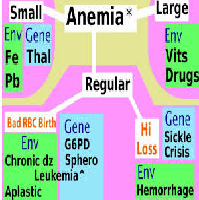
Implementation of the IOM Future of Nursing Order Instructions: Benchmark Assignment: Implementation of the IOM Future of Nursing Report
View Rubric Details:
In a formal paper of 1,000-1,250 words, you will discuss the work of the Robert Wood Johnson Foundation Committee Initiative on the Future of Nursing and the Institute of Medicine research that led to the IOM report, “Future of Nursing: Leading Change, Advancing Health.” Identify the importance of the IOM “Future of Nursing” report related to nursing practice, nursing education and nursing workforce development. What is the role of state-based action coalitions and how do they advance goals of the Future of Nursing: Campaign for Action?
Explore the Campaign for Action webpage (you may need to research your state’s website independently if it is not active on this site): http://campaignforaction.org/states
Review your state’s progress report by locating your state and clicking on one of the six progress icons for education, leadership, practice, interpersonal collaboration, diversity, and data. You can also download a full progress report for your state by clicking on the box located at the bottom of the webpage.
In a paper of 1,000-1,250 words:
1. Discuss the work of the Robert Wood Johnson Foundation Committee Initiative on the Future of Nursing and the Institute of Medicine research that led to the IOM report, “Future of Nursing: Leading Change, Advancing Health.”
2. Identify the importance of the IOM “Future of Nursing” report related to nursing practice, nursing education and nursing workforce development.
3. What is the role of state-based action coalitions and how do they advance goals of the Future of Nursing: Campaign for Action?
Summarize two initiatives spearheaded by your state’s Action Coalition. In what ways do these initiatives advance the nursing profession? What barriers to advancement currently exist in your state? How can nursing advocates in your state overcome these barriers?
A minimum of three scholarly references is required for this assignment.
Prepare this assignment according to the APA guidelines found in the APA Style Guide, located in the Student Success Center. An abstract is not required.
This assignment uses a rubric. Please review the rubric prior to beginning the assignment to become familiar with the expectations for successful completion.
You are required to submit this assignment to Turnitin. Please refer to the directions in the Student Success Center.
Please Note: Assignment will not be submitted to the faculty member until the “Submit” button under “Final Submission” is clicked.
*******RUBRIC*********
Benchmark Assignment: Implementation of the IOM Future of Nursing Report
1
Unsatisfactory
0.00%
2
Less than Satisfactory
75.00%
3
Satisfactory
79.00%
4
Good
89.00%
5
Excellent
100.00%
80.0 %Content
5.0 % Provided an original summary of the key messages of the IOM report, Future of Nursing: Leading Change, Advancing Health. Any specific references should be cited.
Did not attempt to provide a summary of the key messages of the IOM report, Future of Nursing: Leading Change, Advancing Health, or failed to cite specific references to the IOM report.
Provided a skeletal summary of the key messages of the IOM report, Future of Nursing: Leading Change, Advancing Health. Some of the specific references to the IOM report were cited or were done incorrectly.
Demonstrates a moderate knowledge of the subject. Recognizes the basic ideas. Misinterprets evidence on the committee’s initiative.
Demonstrates good knowledge of the subject. Correctly describes the committee’s initiative. Justifies some of the impacts on the Future of Nursing.
Provided an original summary of the key messages of the IOM report, Future of Nursing: Leading Change, Advancing Health. References specific to the IOM report were properly cited.
15.0 % Identify the role of the Robert Wood Johnson Foundation Initiative and the American Association of Retired Persons on the Future of Nursing Campaign for Action and the State-Based Action Coalitions
Does not demonstrate knowledge of role. Fails to identify the impact of the Robert Wood Johnson Foundation Initiative on the Future of Nursing.
Demonstrates minimal knowledge of the subject. Does not adequately visualize or justify the work of the Committee of the Robert Wood Johnson Foundation Initiative on the Future of Nursing.
Demonstrates a moderate knowledge of the subject. Recognizes the basic ideas. Misinterprets evidence on the committee’s initiative.
Demonstrates good knowledge of the subject. Correctly describes the committee’s initiative. Justifies some of the impacts on the Future of Nursing.
Demonstrates full and deep knowledge of the subject. Develops and explains an informed position on the committee’s initiative, integrates and justifies the impact on the Future of Nursing
15.0 % Identify the importance of the IOM FON report related to the nursing workforce
Does not demonstrate knowledge of the concept or its role. Fails to identify the importance of the IOM FON report related to the nursing workforce.
Demonstrates minimal knowledge of the subject. Does not adequately visualize or justify the importance of the IOM FON report related to the nursing workforce.
Demonstrates a moderate knowledge of the subject. Recognizes the basic ideas. Misinterprets evidence on the importance of the IOM FON report related to the nursing workforce.
Demonstrates good knowledge of the subject. Correctly describes the importance of the IOM FON report related to the nursing workforce.
Demonstrates full and deep knowledge of the subject. Develops and explains the importance of the IOM FON report, integrates and justifies the importance of the IOM FON report related to the nursing workforce.
15.0 % Discuss the intent of the Future of Nursing Campaign for Action
Does not demonstrate knowledge of the concept or its role. Fails to identify the intent of the Future of Nursing Campaign for Action.
Demonstrates minimal knowledge of the subject. Does not adequately visualize or identify the intent of the Future of Nursing Campaign for Action.
Demonstrates a moderate knowledge of the subject. Recognizes the basic ideas. Misinterprets evidence on the intent of the Future of Nursing Campaign for Action.
Demonstrates good knowledge of the subject. Correctly describes the intent of the Future of Nursing Campaign for Action.
Demonstrates full and deep knowledge of the subject. Develops and explains the intent of the Future of Nursing Campaign for Action, integrates and justifies the intent of the Future of Nursing Campaign for Action.
15.0 % Identify the rationale of state-based action coalitions
Does not demonstrate knowledge of the concept or its role. Fails to identify the rationale of state-based action coalitions.
Demonstrates minimal knowledge of the subject. Does not adequately identify the rationale of state-based action coalitions.
Demonstrates a moderate knowledge of the subject. Recognizes the basic ideas. Misinterprets evidence on the rationale of state-based action coalitions.
Demonstrates good knowledge of the subject. Correctly identifies the rationale of state-based action coalitions.
Demonstrates full and deep knowledge of the subject. Develops and explains and identifies the rationale of state-based action coalitions and justifies a rationale for state-based action coalitions.
15.0 % Discuss one state-based action coalition and two initiatives
Does not demonstrate knowledge of the concept or its role. Fails to identify one state-based action coalition and two initiatives.
Demonstrates minimal knowledge of the subject. Does not adequately identify one state-based action coalition and two initiatives.
Demonstrates a moderate knowledge of the subject. Recognizes the basic ideas. Identifies but misinterprets one state-based action coalition and two initiatives.
Demonstrates good knowledge of the subject. Correctly identifies one state-based action coalition and two initiatives.
Demonstrates full and deep knowledge of the subject. Develops and explains the one state-based action coalition and two initiatives, integrates and justifies one state-based action coalition and two initiatives.
15.0 %Organization and Effectiveness
5.0 % Thesis Development and Purpose
Paper lacks any discernible overall purpose or organizing claim.
Thesis and/or main claim are insufficiently developed and/or vague; the purpose is not clear.
Thesis and/or main claim are apparent and appropriate to the purpose.
Thesis and/or main claim are clear and forecast the development of the paper. Is descriptive and reflective of the arguments and appropriate to the purpose.
Thesis and/or main claim are comprehensive; contained within the thesis is the essence of the paper. Thesis statement makes the purpose of the paper clear.
15.0 %Organization and Effectiveness
5.0 % Paragraph Development and Transitions
Paragraphs and transitions consistently lack unity and coherence. No apparent connections between paragraphs are established. Transitions are inappropriate to purpose and scope. The organization is disjointed.
Some paragraphs and transitions may lack logical progression of ideas, unity, coherence, and/or cohesiveness. Some degree of organization is evident.
Paragraphs are generally competent, but ideas may show some inconsistency in the organization and/or in their relationships to each other.
A logical progression of ideas between paragraphs is apparent. Paragraphs exhibit a unity, coherence, and cohesiveness. Topic sentences and concluding remarks are appropriate to the purpose.
There is a sophisticated construction of paragraphs and transitions. Ideas progress and relate to each other. Paragraph and transition construction guide the reader. Paragraph structure is seamless.
15.0 %Organization and Effectiveness
5.0 % Mechanics of Writing (includes spelling, punctuation, grammar, language use)
Surface errors are pervasive enough that they impede communication of meaning. Inappropriate word choice and/or sentence construction are used.
Frequent and repetitive mechanical errors distract the reader. Inconsistencies in language choice (register), sentence structure, and/or word choice are present.
Some mechanical errors or typos are present but are not overly distracting to the reader. Correct sentence structure and audience-appropriate language are used.
The prose is largely free of mechanical errors, although a few may be present. A variety of sentence structures and effective figures of speech are used.
The writer is clearly in command of standard, written, academic English.
5.0 %Format
2.0 % Paper Format (1- inch margins;12-point-font;double-spaced;Times New Roman, Arial, or Courier)
The template is not used appropriately or documentation format is rarely followed correctly.
The template is used, but some elements are missing or mistaken; lack of control with formatting is apparent.
The template is used, and formatting is correct, although some minor errors may be present.
The template is fully used; There are virtually no errors in formatting style.
All format elements are correct.
3.0 % Research Citations (In-text citations for paraphrasing and direct quotes, and reference page listing and formatting, as appropriate to assignment)
No reference page is included. No citations are used.
The reference page is present. Citations are inconsistently used.
The reference page is included and lists sources used in the paper. Sources are appropriately documented, although some errors may be present.
The reference page is present and fully inclusive of all cited sources. Documentation is appropriate and GCU style is usually correct.
In-text citations and a reference page are complete. The documentation of cited sources is free of error.
100 % Total Weightage
New York Action Coalition
The Future of Nursing New York State Action Coalition is the driving force for the implementation of the Institute of Medicine recommendations in our state. We are working with diverse stakeholders to create and model innovative solutions that will lead to healthier communities, with nurses leading the way.
Visit Our Website
Blog Posts by:
New York Action Coalition
Fostering Interprofessional Collaboration in Health Care
Collaboration is the cornerstone of success in any team. Interprofessional collaboration is one of the trademarks of several highly successful health care innovations. When nurses collaborate as equals with other health care providers, patient outcomes and quality of more
Issues: Fostering Interprofessional Collaboration, Locations: New Jersey, New York,
Transforming Nursing Education
More highly educated nursing workforce needed to provide more complex patient care, experts say. Many registered nurses (RNs) start—and finish—their post-secondary education with an associate degree in nursing (ADN). But health care experts want more nurses to see more
Issues: Transforming Nursing Education, Locations: National, New York, Texas, Wyoming,
See More Blog Posts for
New York Action Coalition
Our Leaders
Susan Apold
Susan Apold
Professor
New York University College of Nursing
Debbie Stamps
Debbie Stamps
Chief Nursing Officer
Newark-Wayne Community Hospital
Implementation of the IOM Future of Nursing Sample Answer
Benchmark Assignment: Implementation of the IOM Future of Nursing Report
With over 3 million practitioners, the profession of nursing forms the largest section of the US’s health care workforce. Nurses play a central role in assisting patients in realizing the objectives of the Affordable Care Act, legislation that forms a wide range of health care overhaul since the creation of Medicare and Medicaid. However, some obstacles have hindered nurses from effectively responding to the ever changing clinical settings as well as an evolving health care system. These challenges include a shortage of nurses, technological changes, and the shortage of educational opportunities for nursing. These barriers need to be addressed so that nurses can be in the best position of leading change and advancing health.
Work of RWJF Committee Initiative
Robert Wood Johnson Foundation (RWJF) in conjunction with the Institute of Medicine (IOM) established a major initiative that has served as a guide in the future of nursing. RWJF partnered with IOM in conducting a study and developed a report meant to transform the future of nursing. The IOM committee through this study determined potential challenges that were facing the nursing profession and compiled a report on the modifications in institutional policies at the local, state, and national levels. RWJF through the IOM’s study committee reviewed innovative models of nursing education and care delivery and provided solutions that could be used to improve the quality of care delivery at an affordable cost.
RWJF established the initiative of the “Future of Nursing” that examined the potential of promoting the quality and accessibility of care through the use of nursing-led solutions. The report had recommendations geared towards determining significant roles for nurses in planning and executing an effective and efficient health care system.
Some of the recommendations that were highlighted in the report include an examination of innovative solutions associated with the delivery of care and nursing education with a focus on nursing and the provision of patient care. It was also recommended that the nursing faculty should be expanded, the capacity of schools increased, and nursing education be redesigned in order to ensure that it produces a sufficient number of well-prepared nurses that are able to meet health care demands. Fineberg & Lavizzo-Mourey, (2013) state that clinical and community care in the US has become more complex. Therefore, the education provided should equip nurses so that they can make important decisions linked to care for frail patients and work with sophisticated, life-saving technology. The report also pointed out that the role of nurses within the context of the health care workforce, future technology, nursing shortage, and societal issues should be re-conceptualized. Nurses are called upon to collaborate with different health care professionals and coordinate care across different settings. Moreover, the committee proposed that for improved patient outcomes to be realized, the health care sector should attract and retain competent nurses in different care settings such as acute, primary care, ambulatory care, long term care, public, and community health.
The RWJF used the report in its extensive communication in conjunction with the IOM. To support the initiative, the RWJF sponsored a team of experts who discussed the issues raised by the IOM committee. The IOM also played a vital role in the development of the report. For instance, it provided evidence-based proposals to clinicians, private stake holders as well as the general public and provided independent, objective, and technical advice to policymakers. Additionally, the IOM ensured that the recommendations that were developed had an agenda that was clearly defined with an action plan that was properly formulated.
The Importance of the IOM Report
The recommendations provided by the IOM in report center around the vital intersection between the actions of the nursing workforce and the health care needs of different people across the lifespan (Reed, 2015, November). They are meant to promote the efforts of improving the health of the people of US through contributions of nurses. They have an impact in various nursing aspects such as;
- Nursing Practice
Nurses have a great potential of leading innovative strategies tailored towards improving the health care system. However, a number of state regulations limit the scope of nursing practice. Depending on the state, regulations on the scope of nursing practice of a RN may deny or limit prescriptions of medications, admission of patients, assessment of patient conditions, and evaluation of tests. However, the IOM report insists that nurses should provide care to the full extent of their education and training. This has promoted delivery of quality care as nurses provide necessary care with a little limitation of the potential.
- Nursing education
Through the report, profound changes were introduced in nursing education both before and after receiving a license (Keating, 2014). This resulted in the betterment of nursing education which has ensured that the current and future generations of nurses provide quality, patient-centered, safe, care across settings. Nurses have also been encouraged to act in response to the demands of the ever-changing health care sector by attaining higher levels of education and training.
- Nursing workforce
To address the issue of a nursing shortage, the implementation of the IOM report has led to the entry of a greater number of nurses with a baccalaureate degree early in their life. The report has also resulted in the transformation of the practice environment through a balance of skills and perspectives among nurses and other health care providers.
Role of State-Based Action Coalitions and the Future of Nursing
States in the US have formed state-based coalitions that are aimed at enhancing the implementation of the proposed IOM recommendations. These coalitions mobilize stakeholders in the health care sector in order to promote the development of a clear plan of action. The state of New York has been in the frontline in shaping the future of nursing practice. For instance, it has adopted an initiative that is geared towards promoting nursing education for it to be in line with set standards necessitate so that is can meet the complex nature of the health care sector (Campaign for Action, 2014). The initiative also proposes that nurses should take up leadership roles in the promotion of the health care system. The objective of this initiative is to make sure that nurses know their roles as leaders and the public acknowledges the competence of nurses when promoting strategies. The state of New York has also built a strong and highly-competent nursing workforce. These initiatives have given the state’s nurses the opportunity of contributing actively in the promotion of care delivery.
The state of New York has been barred by barriers which limit proper advancement of IOM recommendations. One such barrier is the shortage of nursing workforce. This has resulted in overworking of the nursing leading to job burnout which in turn prevent delivery of quality patient care. It is also important to note the insufficient of nursing workforce has also resulted in an increase in hospitalization cases. Nursing advocates can play a central role in ensuring that the IOM recommendations are achieved. For instance, the advocates can engage actively in decision making processes that will introduce transformational policies in the health care sector. The barrier of nursing shortage can be addressed through increasing admission of undergraduate nursing students and increasing nursing schools. The policies should also target nursing education so that it can enlighten the nurses on how to deliver quality care despite the myriad of challenges facing the health care sector.
Implementation of the IOM Future of Nursing Conclusion
The US has the potential of transforming its health care sector and nurses should contribute majorly in this transformation. The IOM report has been essential in the health care sector as it calls on nurses to play a central role in America’s increasingly multifaceted health care system. Moreover, nurses have been urged to adopt leadership roles in all care settings so that they can satisfy the demands of the evolving health care. The health care delivery competencies has enabled nurses to examine the likely evolution of the health care sector, evaluate their career goals, and determine what should be done to achieve the set objectives. Some of the interventions that have been put forward include advancement of academic education, continuing education, as well as certification. These advancements have been necessary in equipping nurses with appropriate skills for tackling the challenges they encounter. However, the efforts of improving the organizational conditions not only rest solely on nurses but also on health care organizations, the government, insurance industry, and professional associations. Collaboration of these diverse parties will help in ensuring that the health sector offers affordable, seamless, quality care that is easily accessible.
Implementation of the IOM Future of Nursing References
Campaign for Action. (2014). Transforming nursing education. Retrieved from http://campaignforaction.org/transforming-nursing-education/
Fineberg, H. V., &Lavizzo-Mourey, R. (2013). The future of nursing: A look back at the landmark IOM report.
Keating, S. B. (2014). Curriculum development and evaluation in nursing. Springer Publishing Company.
Reed, J. (2015, November). Creating a Culture of Health: Opportunities for Public Health Nursing to partner with State Action Coalitions. In 143rd APHA Annual Meeting and Exposition (October 31-November 4, 2015). APHA.












